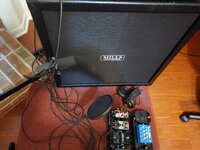Smash
Hack
Killertone posted this video which is interesting. It got me thinking because i have never used a 57. I use a SM7B for close micing and it sounds like my in the room sound. It is smooth and doesn't add any fizziness or make it sound different in any way that i can detect. I suppose it could also be my room (my den or second living room). It is open to the rest of the house which is tile. Gives the room a natural reverb. The room is the opposite of what people tell you you want for recording. As loud as I play, the whole house shakes when I get up to about 117 dbs. It doesn't sound good, because dishes are rattling and shit, but if i stay down to 112 or less and tape the strings on my acoustic guitars, I am in business. But my point is, I have never used a 57, but when i hear clips with it a lot of the time, there is this fizziness that i don't hear in the in the room clips. Is that from close micing, or is that from the mic itself? I don't know why I chose the 7b instead, but I don't really focus too much on position of the mic to cone or distance from cab. I just throw the thing into position just eyeballing about 2 inches inside the outer rim of the cone and maybe 6" from cab, but mainly where ever the mic lands in the 10 seconds i will allow for positioning. I also put the mic at a 45 degree angle.

